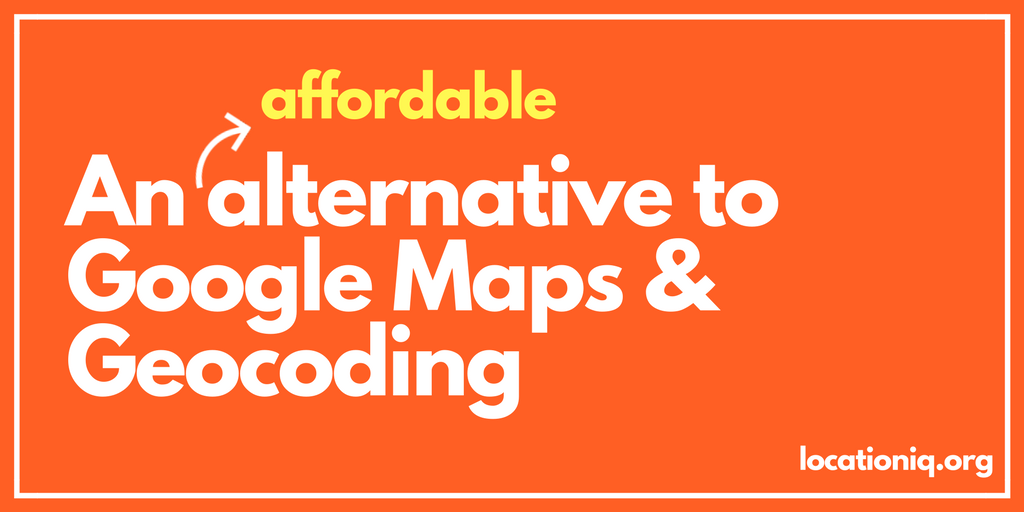As businesses across the world continue to develop powerful software and applications that rely on geospatial capabilities, the decision of which mapping platform to use often becomes a critical one. Do you go with the world-renowned solution, Google Maps, and its vast network of mapping APIs? Or, is it a better choice to leverage OpenStreetMap, the open source mapping platform that serves as a powerful alternative? These questions often lead to the age old ‘open source vs. closed source’ debate and make it a personal choice for every business based on their long term interest.
This post will explore the design and capabilities of OpenStreetMap against Google. If you’re in the market for geocoding, map tiles, or routing APIs, read on as we make a case for why open source is the way to go for your business.
History
Google Maps, the world’s most popular mapping platform was established in 2005. It is made up of data owned by Google and obtained from various sources like satellites, sensors, and ground surveys. Businesses use it by obtaining a license from Google for a fee. Its popularity comes from its comprehensive set of tools to create 3D experiences, search for places, navigate roads, monitor traffic and much more.
OpenStreetMap, on the other hand, was launched in 2004 as a response to the need for open and freely available mapping services. OpenStreetMap relies on a community of volunteers to contribute geographic data, making it a unique and valuable source of open data. The data contributed to OpenStreetMap is available the ODbL license, making it free to use for any purpose, including commercial use.
Factors to Consider

A. Cost-effectiveness
Google primarily offers a pay-as-you-go pricing model where charges are based on the number for requests used on a postpaid basis. Google offers free usage worth $200 per month and costs for each API request beyond this varies based on the type of API being used. For example, pricing for the geocoding API is $5 USD per 1,000 requests.
OpenStreetMap, on the other hand, offers free geocoding API through the Nominatim service. There are restrictions in place as it is run on donated servers and isn’t designed to support demanding commercial use cases. The requests are limited to 1 per second and there are strict measures in place to prevent scraping. OpenStreetMap recommends using external providers like LocationIQ (and others) to navigate this. LocationIQ offers a free plan with 5000 requests/day at a rate limit of 2/second.
Takeaway:
- Google’s pricing model is complex and it can be cost-prohibitive for some businesses, especially small to medium sized ones. When it comes to cost effectiveness, it’s hard to beat providers that use OpenStreetMap and other open source datasets. For example:
- Google’s pricing for 300k requests /month is $1300
- LocationIQ’s pricing for 300k requests /month is $49

B. Data accuracy
Google Maps has a much larger user base, which allows them to deploy an army of data accuracy checks, from verifying addresses to spotting errors in routes and distances. Additionally, millions of businesses use Google Maps, giving the application a far larger pool of data to draw from.
- Google maps has excellent POI data including street/house numbers, names of offices, restaurants, apartment complexes etc. This is further enhanced by the inclusion of working hours, phone numbers and reviews.
OpenStreetMap is built and maintained by a large community of volunteers, who do a great job at collecting and providing accurate, updated data. Accuracy is not consistent across the entire globe and some remote areas may not be accurately mapped, but there is an active community improving maps in such areas by involving local contributors.
- With OpenStreetMap, You can expect excellent street level data worldwide with good POI data in certain geographies.
Takeaway
- All in all, based on your implementation, both Google Maps and OpenStreetMap offer reliable data accuracy. Third-party providers like LocationIQ bridge this gap by combining OpenStreetMap data with other open source datasets like OpenAddresses, WhosOnFirst, Geonames and more. If you need last mile delivery, Google Maps is definitely the way to go.
- Google offers excellent Door/House level and POI Data required for Deliveries
- OpenSource datasets offer excellent street level data. Door/House level and POI Data is on a best effort basis.

C. Flexibility
Google Maps strictly regulates access to its data by essentially creating a “walled garden” that strictly governs how developers and businesses can use its data. For example, results from Google’s geocoding API, cannot be displayed on any map and must be used exclusively on Google Maps. Further, the limitations around caching policy limits the amount of optimization that can be done and reinforces the confines of the walled garden.
OpenStreetMap, and other open source datasets offer far greater flexibility in terms of usage and redistribution of data. LocationIQ, a third-party provider using OpenStreetMap, provides greater flexibility compared to Google Maps, with no limitations on usage even on the free plan. The relaxed caching policy allows businesses to optimize their operations and minimize API calls. Additionally, there are no vendor lock-ins, enabling data from one provider to be displayed on maps from another provider, making switching providers a relatively easy task due to consistent use of OSM_IDs and OSM_Type across providers using OpenStreetMap data.
Takeaway
- Google Maps has strict regulations on accessing its data and usage, creating a “walled garden” environment.
- OpenStreetMap and other open source datasets offer greater flexibility in terms of usage and redistribution of data.
- LocationIQ, a third-party provider using OpenStreetMap, allows commercial use on the free plan, a relaxed caching policy, and no vendor lock-ins.
| Particulars | OpenSource | |
|---|---|---|
| Accuracy | Excellent Street and POI data | Excellet Street Level data |
| Data Source | Proprietary | Community Contributed |
| Pricing | Expensive | Affordable |
| Caching Policy | Restrictive | Friendly |
| Vendor-Lock-in | Yes | No |
| Switching to Another Provider | Difficult | Easy |
The Verdict
So, who wins between Google Maps and OpenStreetMap? For a lot of businesses the right answer is OpenStreetMap and other platforms offering Open Source data. The Price-to-features ratio available in most open source platforms makes it the obvious choice. If your business needs hyper precise door level address data, Google’s proprietary datasets are far ahead of the competition.
Next Steps
Sign Up for an account with LocationIQ and check out how a combination of OpenStreetMap and other open source datasets work for you. Reach out to us here for an honest conversation on what works best for your implementation.



